Abstract
The fate of an intravenous dose of tritiated vitamin D3 was studied in seven normal subjects, four children with vitamin D-resistant rickets, and four adults with a familial history of vitamin D-resistant rickets and persistent hypophosphatemia. An abnormal metabolism of vitamin D in vitamin D-resistant rickets was defined and characterized by a decrease in the plasma fractional turnover rate, a marked increase in plasma water-soluble metabolites, and a relative decrease in the conversion of vitamin D to a polar, biologically active metabolite. Alterations in vitamin D metabolism in the adults with persistent hypophosphatemia were similar but less severe than those of affected children with vitamin D-resistant rickets. It is tentatively concluded that the abnormalities in vitamin D metabolism documented in patients with vitamin D-resistant rickets and familial hypophosphatemia may account for the observed osseous and biochemical changes.
Full text
PDF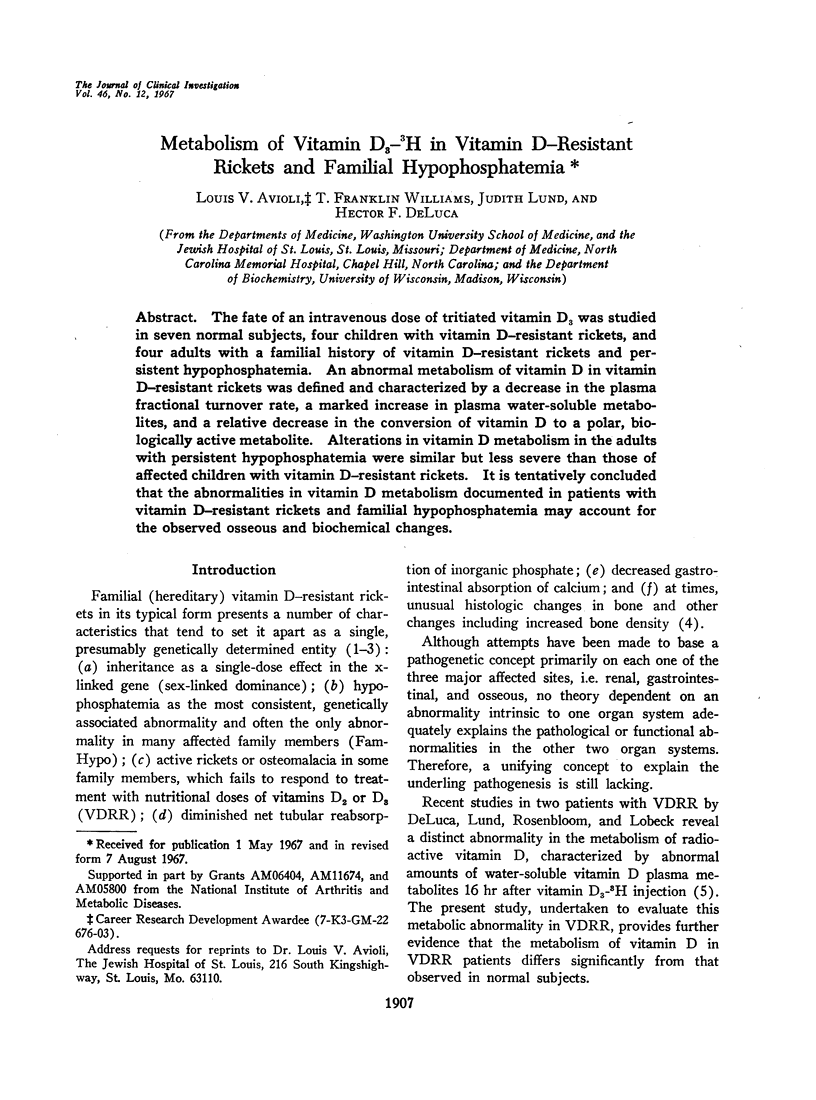
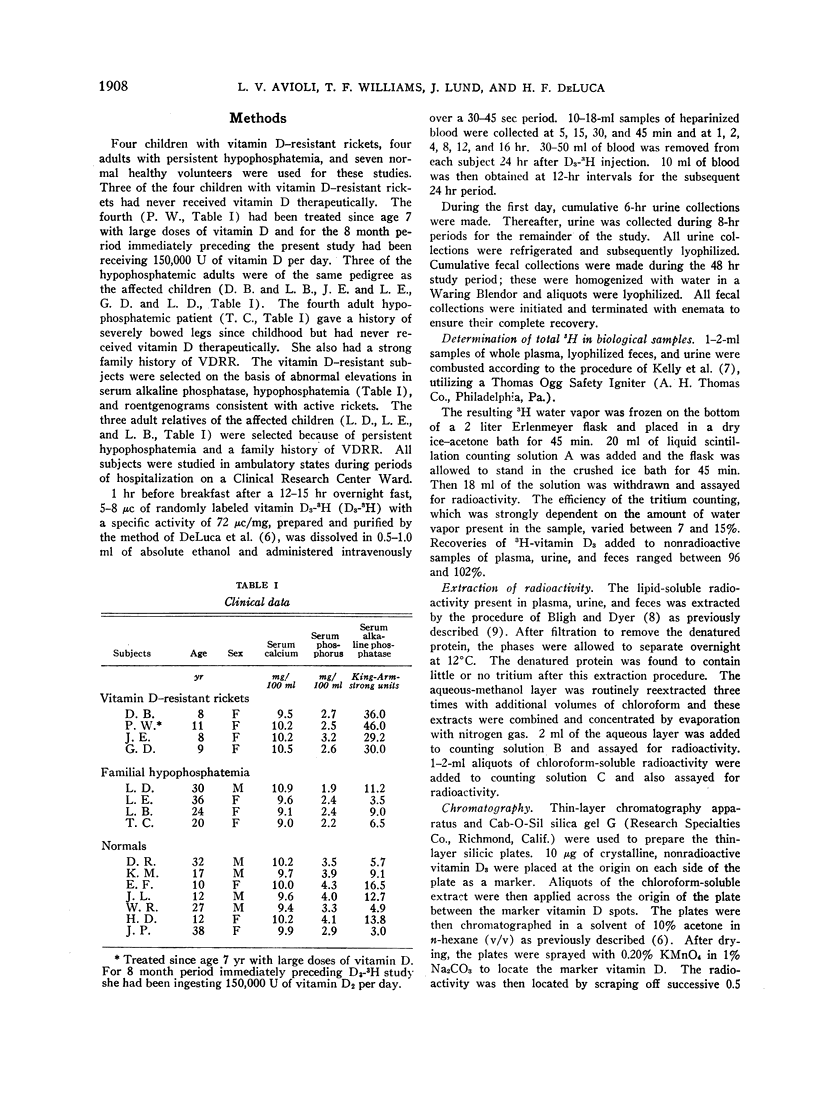

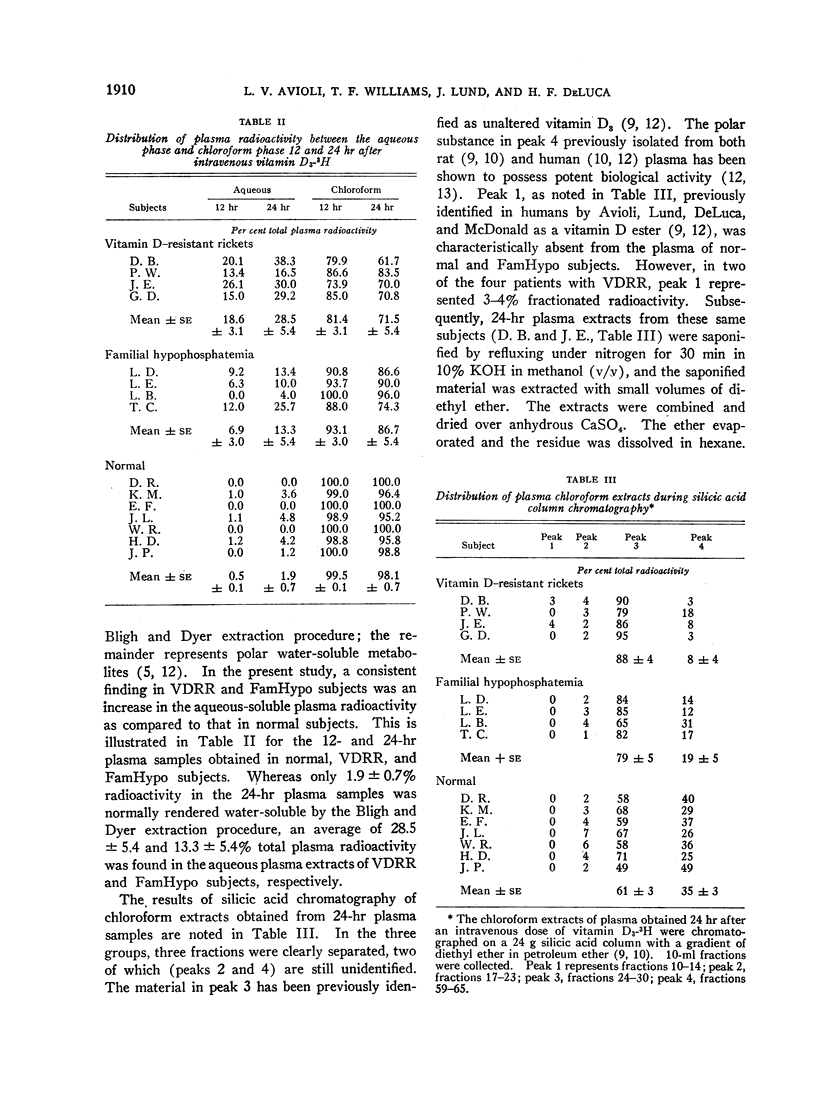
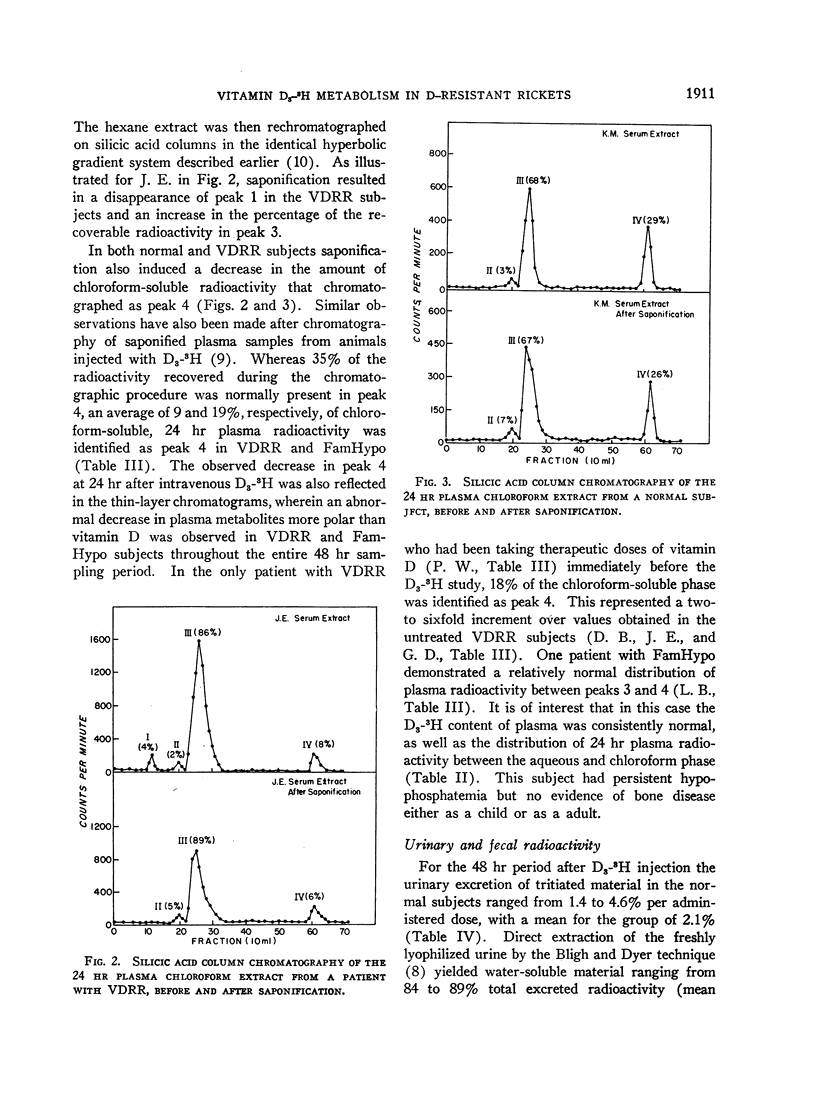
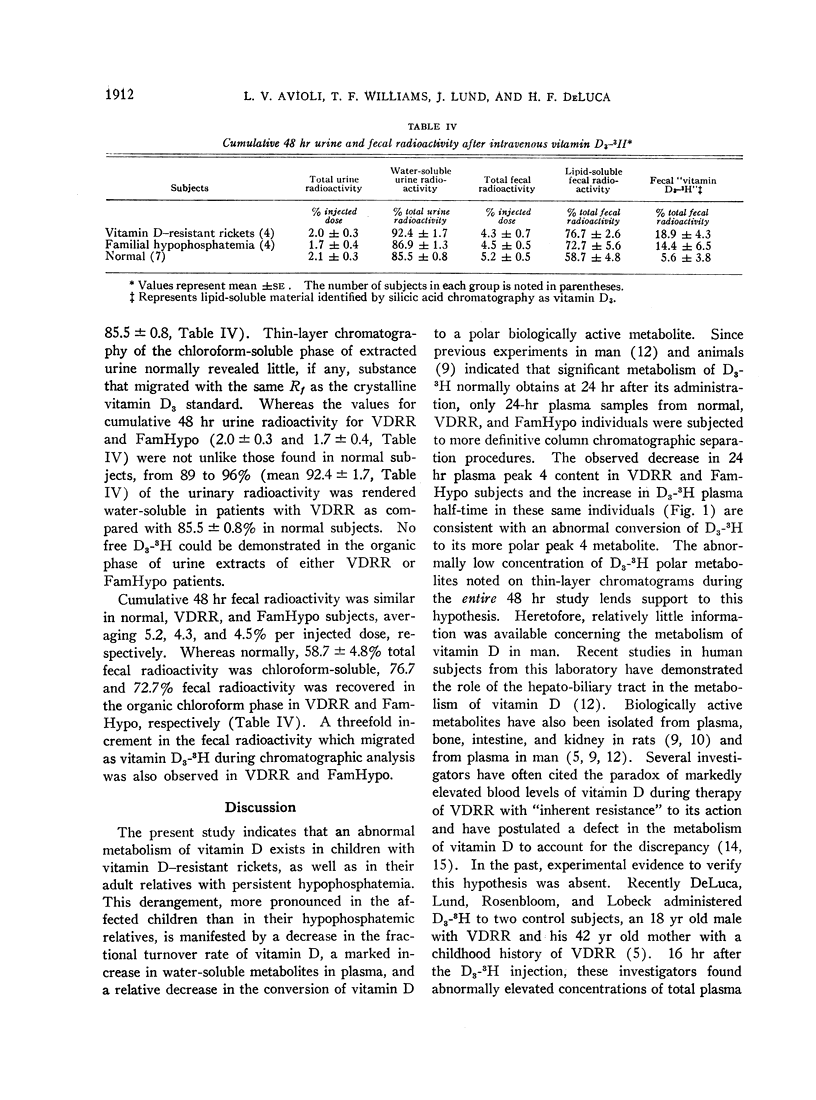
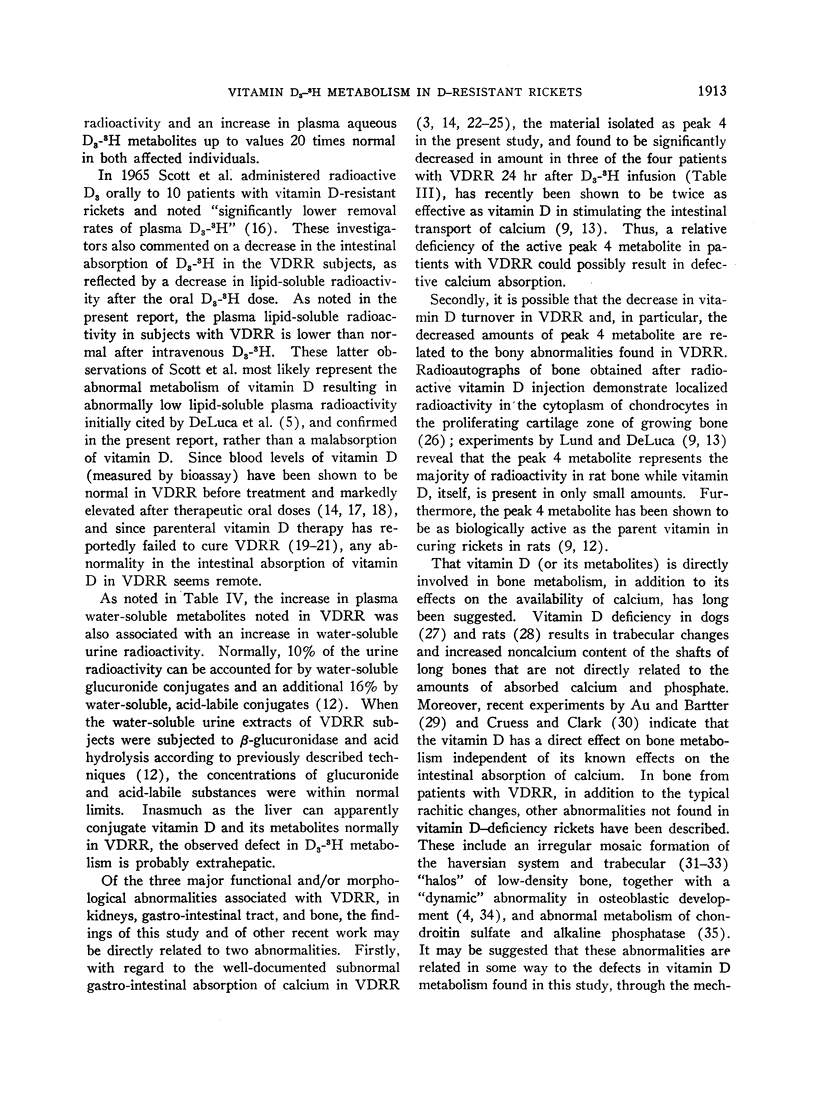
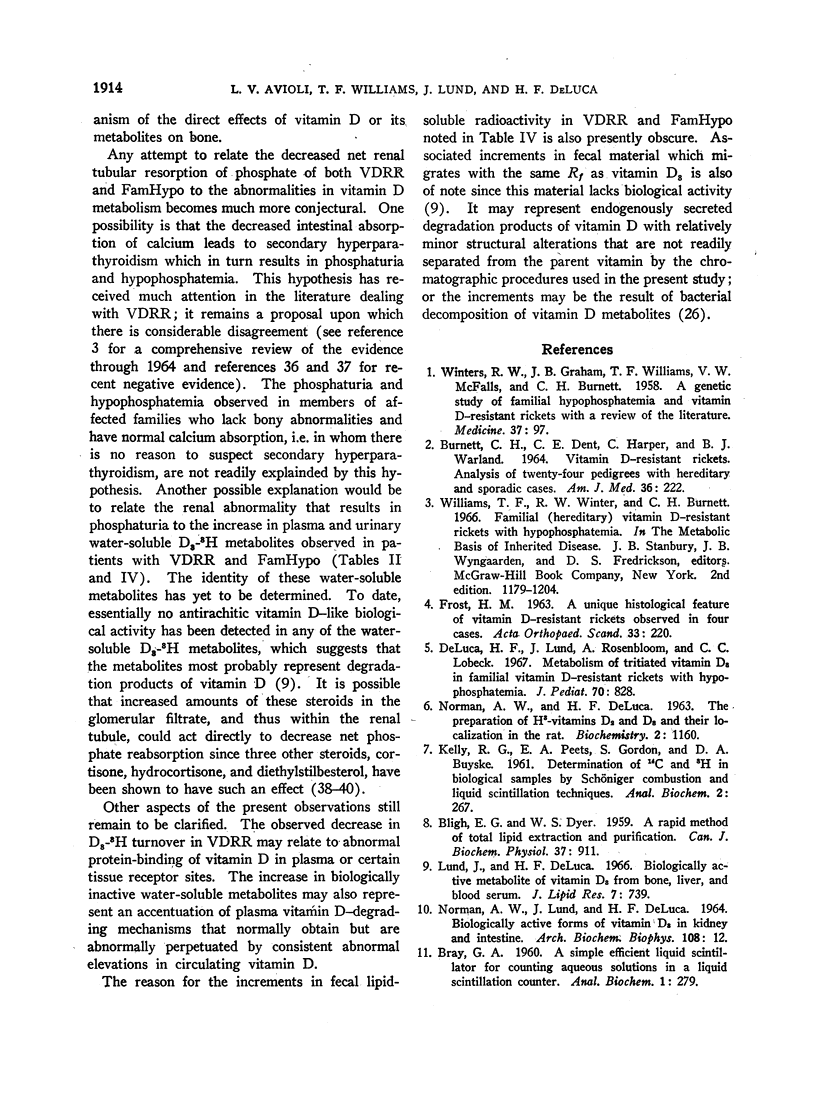
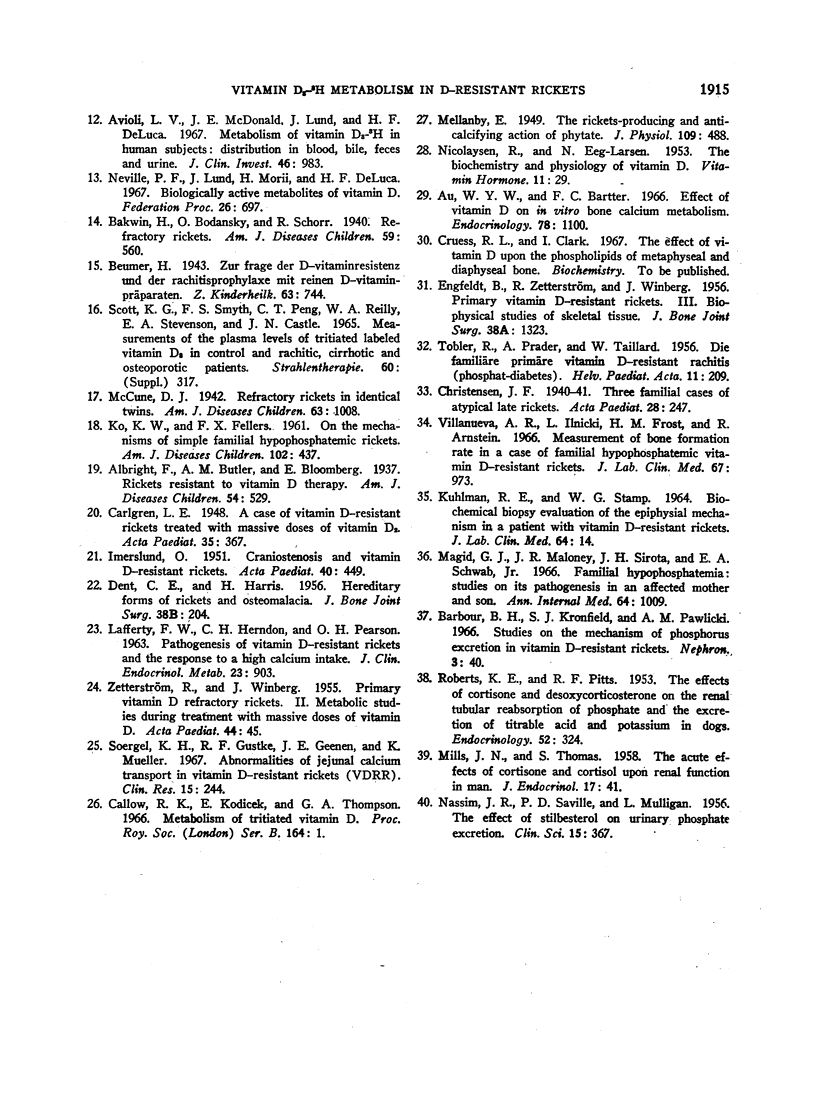
Selected References
These references are in PubMed. This may not be the complete list of references from this article.
- Au W. Y., Bartter F. C. Effect of vitamin D on in vitro bone calcium metabolism. Endocrinology. 1966 Jun;78(6):1100–1104. doi: 10.1210/endo-78-6-1100. [DOI] [PubMed] [Google Scholar]
- Avioli L. V., Lee S. W., McDonald J. E., Lund J., DeLuca H. F. Metabolism of vitamin D3-3H in human subjects: distribution in blood, bile, feces, and urine. J Clin Invest. 1967 Jun;46(6):983–992. doi: 10.1172/JCI105605. [DOI] [PMC free article] [PubMed] [Google Scholar]
- BLIGH E. G., DYER W. J. A rapid method of total lipid extraction and purification. Can J Biochem Physiol. 1959 Aug;37(8):911–917. doi: 10.1139/o59-099. [DOI] [PubMed] [Google Scholar]
- BURNETT C. H., DENT C. E., HARPER C., WARLAND B. J. VITAMIN D-RESISTANT RICKETS. ANALYSIS OF TWENTY-FOUR PEDIGREES WITH HEREDITARY AND SPORADIC CASES. Am J Med. 1964 Feb;36:222–232. doi: 10.1016/0002-9343(64)90085-3. [DOI] [PubMed] [Google Scholar]
- Barbour B. H., Kronfield S. J., Pawlicki A. M. Studies on the mechanism of phosphorus excretion in vitamin D resistant rickets. Nephron. 1966;3(1):40–58. doi: 10.1159/000179424. [DOI] [PubMed] [Google Scholar]
- Callow R. K., Kodicek E., Thompson G. A. Metabolism of tritiated vitamin D. Proc R Soc Lond B Biol Sci. 1966 Feb 15;164(994):1–20. doi: 10.1098/rspb.1966.0010. [DOI] [PubMed] [Google Scholar]
- DENT C. E., HARRIS H. Hereditary forms of rickets and osteomalacia. J Bone Joint Surg Br. 1956 Feb;38-B(1):204–226. doi: 10.1302/0301-620X.38B1.204. [DOI] [PubMed] [Google Scholar]
- DeLuca H. F., Lund J., Rosenbloom A., Lobeck C. C. Metabolism of tritiated vitamin D3 in familial vitamin D-resistant rickets with hypophosphatemia. J Pediatr. 1967 May;70(5):828–832. doi: 10.1016/s0022-3476(67)80342-1. [DOI] [PubMed] [Google Scholar]
- ENGFELDT B., WINBERG J., ZETTERSTROM R. Primary vitamin-D resistant rickets. III. Biophysical studies of skeletal tissue. J Bone Joint Surg Am. 1956 Dec;38-A(6):1323–1334. [PubMed] [Google Scholar]
- FROST H. M. A UNIQUE HISTOLOGICAL FEATURE OF VITAMIN D RESISTANT RICKETS OBSERVED IN FOUR CASES. Acta Orthop Scand. 1963;33:220–226. doi: 10.3109/17453676308999848. [DOI] [PubMed] [Google Scholar]
- IMERSLUND O. Craniostenosis and vitamin D resistant rickets. Acta Paediatr. 1951 Sep;40(5):449–456. doi: 10.1111/j.1651-2227.1951.tb16509.x. [DOI] [PubMed] [Google Scholar]
- KELLY R. G., PEETS E. A., GORDON S., BUYSKE D. A. Determination of C-14 and H3 in biological samples by Schoeniger combustion and liquid scintillation techniques. Anal Biochem. 1961 Jun;2:267–273. doi: 10.1016/s0003-2697(61)80010-9. [DOI] [PubMed] [Google Scholar]
- KUHLMAN R. E., STAMP W. G. BIOCHEMICAL BIOPSY EVALUATION OF THE EPIPHYSIAL MECHANISM IN A PATIENT WITH VITAMIN D-RESISTANT RICKETS. J Lab Clin Med. 1964 Jul;64:14–20. [PubMed] [Google Scholar]
- LAFFERTY F. W., HERNDON C. H., PEARSON O. H. PATHOGENESIS OF VITAMIN D-RESISTANT RICKETS AND THE RESPONSE TO A HIGH CALCIUM INTAKE. J Clin Endocrinol Metab. 1963 Sep;23:903–917. doi: 10.1210/jcem-23-9-903. [DOI] [PubMed] [Google Scholar]
- Lund J., DeLuca H. F. Biologically active metabolite of vitamin D3 from bone, liver, and blood serum. J Lipid Res. 1966 Nov;7(6):739–744. [PubMed] [Google Scholar]
- MELLANBY E. The rickets-producing and anti-calcifying action of phytate. J Physiol. 1949 Sep;109(3-4):488-533, 2 pl. doi: 10.1113/jphysiol.1949.sp004411. [DOI] [PMC free article] [PubMed] [Google Scholar]
- MILLS J. N., THOMAS S. The acute effects of cortisone and cortisol upon renal function in man. J Endocrinol. 1958 May;17(1):41–53. doi: 10.1677/joe.0.0170041. [DOI] [PubMed] [Google Scholar]
- MULLIGAN L., NASSIM J. R., SAVILLE P. D. The effect of stilboestrol on urinary phosphate excretion. Clin Sci. 1956 Aug;15(3):367–371. [PubMed] [Google Scholar]
- Magid G. J., Maloney J. R., Sirota J. H., Schwab E. A., Jr Familial hypophosphatemia. Studies on its pathogenesis in an affected mother and son. Ann Intern Med. 1966 May;64(5):1009–1027. doi: 10.7326/0003-4819-64-5-1009. [DOI] [PubMed] [Google Scholar]
- NICOLAYSEN R., EEG-LARSEN N. The biochemistry and physiology of vitamin D. Vitam Horm. 1953;11:29–60. doi: 10.1016/s0083-6729(08)61094-8. [DOI] [PubMed] [Google Scholar]
- NORMAN A. W., DELUCA H. F. THE PREPARATION OF H3-VITAMINS D2 AND D3--THEIR LOCALIZATION IN THE RAT. Biochemistry. 1963 Sep-Oct;2:1160–1168. doi: 10.1021/bi00905a044. [DOI] [PubMed] [Google Scholar]
- NORMAN A. W., LUND J., DELUCA H. F. BIOLOGICALLY ACTIVE FORMS OF VITAMIN D3 IN KIDNEY AND INTESTINE. Arch Biochem Biophys. 1964 Oct;108:12–21. doi: 10.1016/0003-9861(64)90349-2. [DOI] [PubMed] [Google Scholar]
- PRADER A., TAILLARD W., TOBLER R. Die familiäre vitamin-D-resistente Rachitis (Phosphatdiabetes). Helv Paediatr Acta. 1956 Sep;11(3):209–255. [PubMed] [Google Scholar]
- ROBERTS K. E., PITTS R. F. The effects of cortisone and desoxycorticosterone on the renal tubular reabsorption of phosphate and the excretion of titratable acid and potassium in dogs. Endocrinology. 1953 Mar;52(3):324–330. doi: 10.1210/endo-52-3-324. [DOI] [PubMed] [Google Scholar]
- Villanueva A. R., Ilnicki L., Frost H. M., Arnstein R. Measurement of the bone formation rate in a case of familial hypophosphatemic vitamin D-resistant rickets. J Lab Clin Med. 1966 Jun;67(6):973–982. [PubMed] [Google Scholar]
- WINTERS R. W., GRAHAM J. B., WILLIAMS T. F., McFALLS V. W., BURNETT C. H. A genetic study of familial hypophosphatemia and vitamin D resistant rickets with a review of the literature. Medicine (Baltimore) 1958 May;37(2):97–142. doi: 10.1097/00005792-195805000-00001. [DOI] [PubMed] [Google Scholar]


